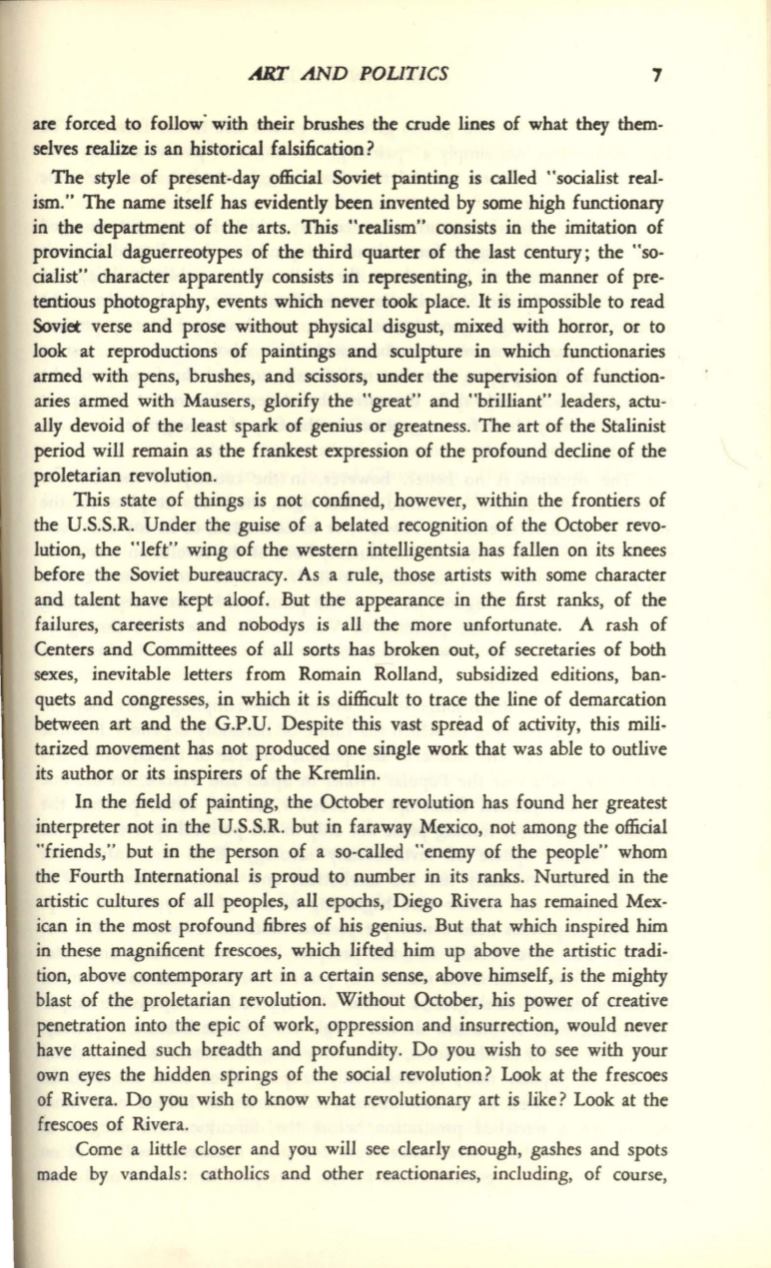
ART AND POLITICS
7
are forced to follow' with their brushes the crude lines of what they them–
selves realize is an historical falsification?
The style of present-day official Soviet painting is called "socialist real–
ism." The name itself has evidently been invented by some high functionary
in the department of the arts. This "realism" consists in the imitation of
provincial daguerreotypes of the third quarter of the last century; the "so–
cialist" character apparently consists in representing, in the manner of pre–
tentious photography, events which never took place.
It
is impossible to read
Soviet verse and prose without physical disgust, mixed with horror, or to
look at reproductions of paintings and sculpture in which functionaries
armed with pens, brushes, and scissors, under the supervision of function–
aries armed with Mausers, glorify the "great" and "brilliant" leaders, actu–
ally devoid of the least spark of genius or greatness. The art of the Stalinist
period will remain as the frankest expression of the profound decline of the
proletarian revolution.
This state of things is not confined, however, within the frontiers of
the U.S.S.R. Under the guise of a belated recognition of the October revo–
lution, the "left" wing of the western intelligentsia has fallen on its knees
before the Soviet bureaucracy. As a rule, those artists with some character
and talent have kept aloof. But the appearance in the first ranks, of the
failures, careerists and nobodys is all the more unfortunate. A rash of
Centers and Committees of all sorts has broken out, of secretaries of both
sexes, inevitable letters from Romain Rolland, subsidized editions, ban–
quets and congresses, in which it is difficult to trace the line of demarcation
between art and the G.P.u. Despite this vast spread of activity, this mili–
tarized movement has not produced one single work that was able to outlive
its author or its inspirers of the Kremlin.
In the field of painting, the October revolution has found her greatest
interpreter not in the U.S.S.R. but in faraway Mexico, not among the official
"friends," but in the person of a so-called "enemy of the people" whom
the Fourth International is proud to number in its ranks. Nurtured in the
artistic cultures of all peoples, all epochs, Diego Rivera has remained Mex–
ican in the most profound fibres of his genius. But that which inspired him
in these magnificent frescoes, which lifted him up above the artistic tradi–
tion, above contemporary art in a certain sense, above himself, is the mighty
blast of the proletarian revolution. Without October, his power of creative
penetration into the epic of work, oppression and insurrection, would never
have attained such breadth and profundity. Do you wish to see with your
own eyes the hidden springs of the social revolution? Look at the frescoes
of Rivera. Do you wish to know what revolutionary art is like? Look at the
frescoes of Rivera.
Come a little closer and you will see clearly enough, gashes and spots
made by vandals : catholics and other reactionaries, including, of course,


